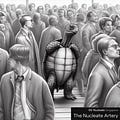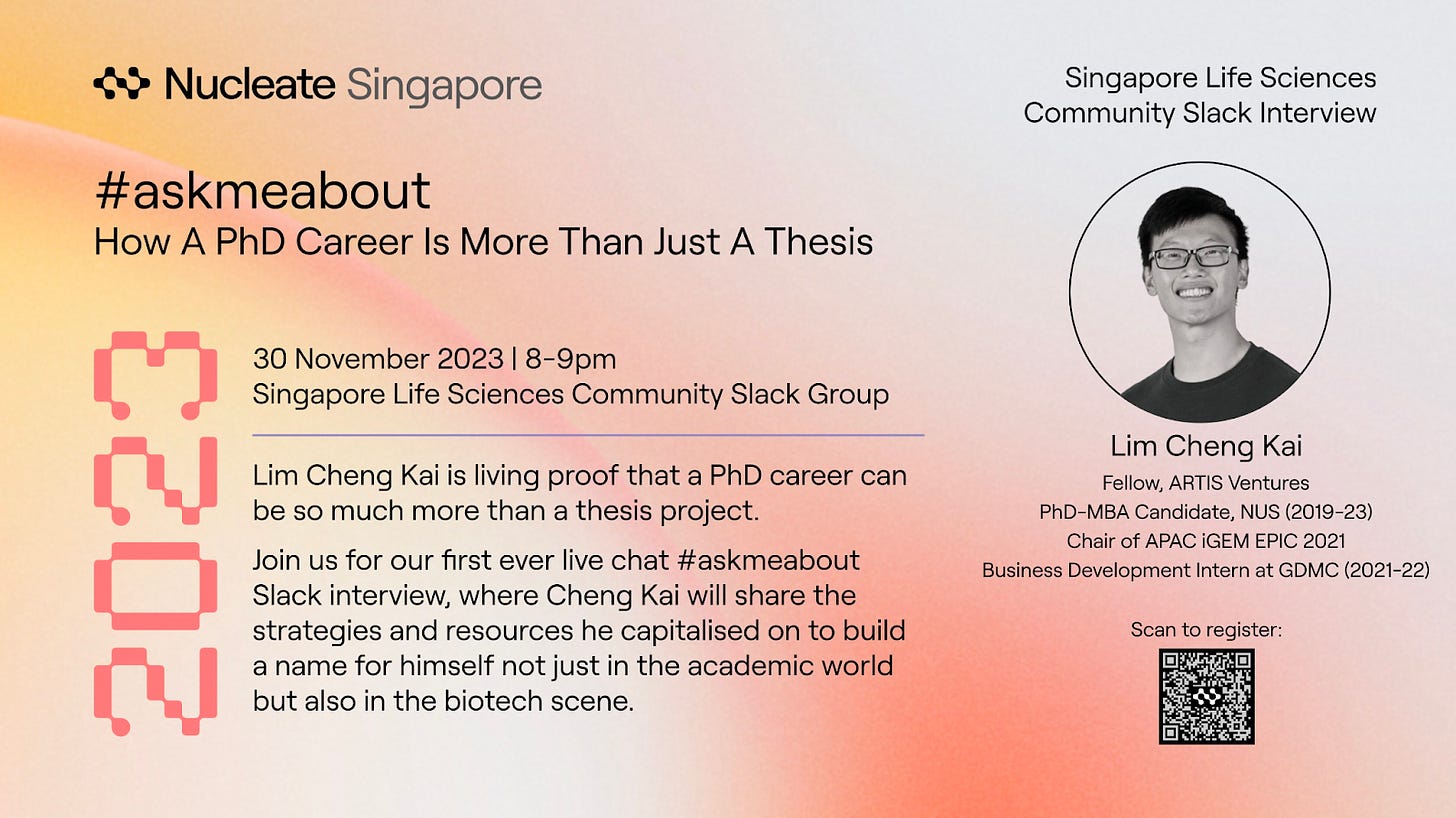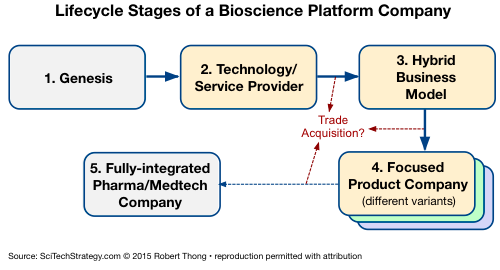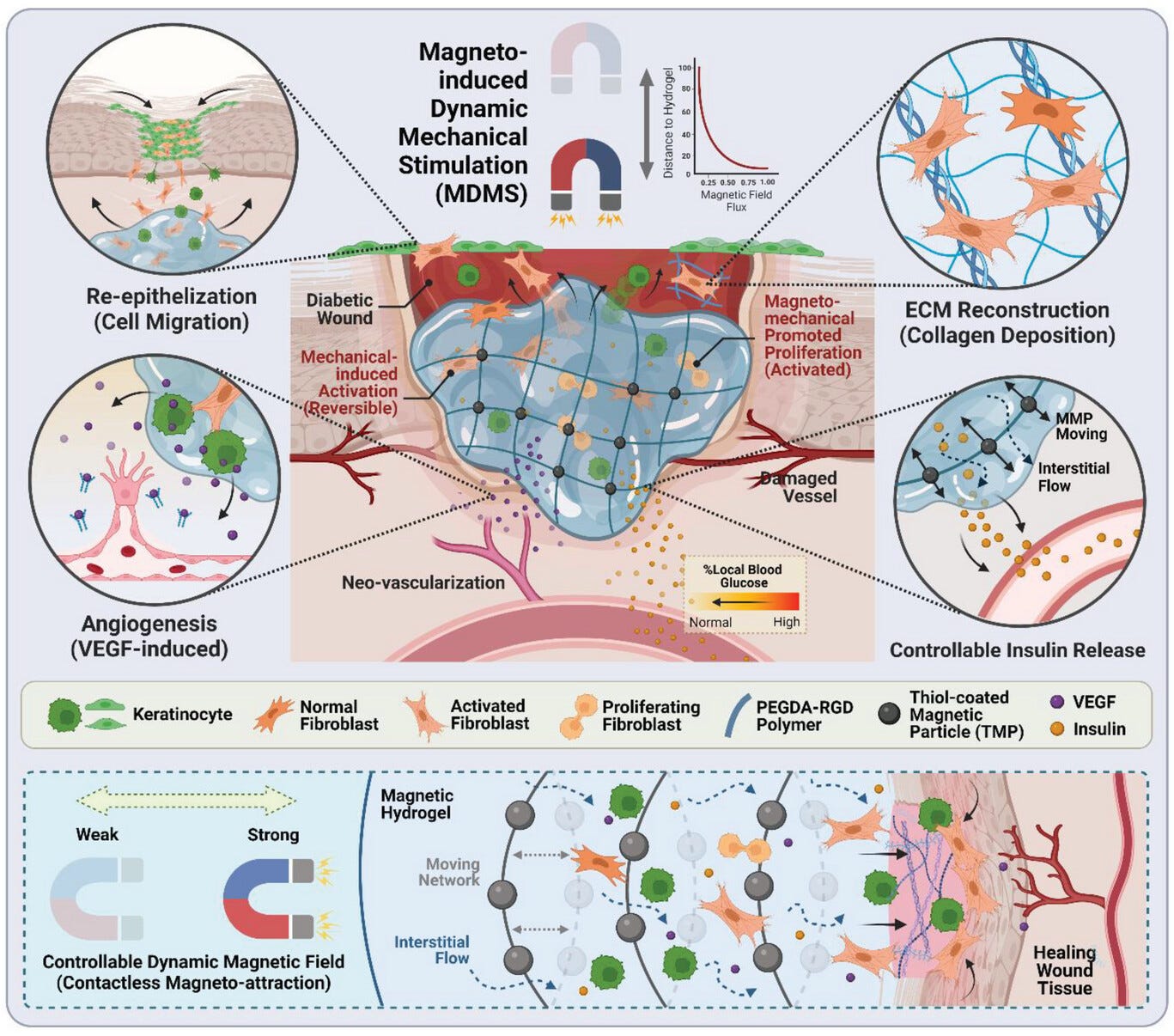The Nucleate Artery: AI-driven RNA Structure Prediction, Diabetic Wound Management and Overcoming Networking Jitters!
…AND IT’S A WRAP! 🎉 In the past weeks, we held our inaugural Ignite Venture Capital Workshop in collaboration with ClavystBio; it was a three-part series covering the intricacies of venture capital investment that featured three esteemed speakers: Dr. Wen Qi Ho, Dr. Alice Chen, and Dr. Kim Png.
Our team would like to extend our heartfelt appreciation to everyone, including the participants, who have contributed to the success of the workshop. We hope the sessions were meaningful for your biotech and entrepreneurship journeys, and that the connections you have forged will continue to flourish! Also keep your eyes peeled for our next Ignite Therapeutic Development Workshop coming to you soon 👀
OTHER EXCITING NEWS — At the end of this month, we are thrilled to be able to host Cheng Kai Lim, PhD-MBA candidate at the NUS and Fellow at ARTIS Ventures, for an exclusive Ask-Me-Anything Slack interview. In a change of perspective, we will explore his journey navigating a PhD-MBA and discover the secrets behind his success in establishing a prominent presence in both the academic and biotech sectors. To all academic trainees whether you're considering a PhD, in the midst of one, or exploring diverse career paths, this is a valuable opportunity for you!
No time today? Here’s a TL;DR:
🧬 DRfold is a method that models RNA tertiary structures for drug discovery. RNA structure modelling contributes to RNA drug discovery, which is one approach to expanding therapeutic options for parts of the genome that so far has been deemed ‘undruggable’.
🩹 A new hydrogel incorporates skin cells and magnetic particles to accelerate diabetic wound healing. When applied to mouse models and stimulated by an external magnetic field, it demonstrates a three-fold improvement in wound closure. This FDA-approved technology is responsive to glucose regulation at wound sites and has the potential to provide on-demand insulin, addressing previously unmet factors in diabetic pathology.
🤝 We attended SGInnovate’s Networking Night, and reflected on our experiences networking at an industry event. We encourage evergreen networkers to overcome their apprehensions to attend such events by practising telling their life narratives and showing the same resilience as they do in their research!
🍽️ Digestibles
(Research that has been published within the past 2 months)
1. Unravelling the RNA Riddle: DRfold unfolds!
In the ongoing pursuit of medical advancements, it is striking to note that only a mere 0.05% of the human genome has been targeted through conventional protein-small molecules/antibody drug interactions [1]. The reason becomes clear when you consider that the broader pool of disease-related proteins accounts only for 0.2% of the human genome, and many are deemed 'undruggable' due to a lack of appropriate binding sites. Therefore, transitioning to RNA-focused therapeutics is pivotal, offering transformative expansion of therapeutic targets and opening new avenues for medical intervention. Yet, in the quest for RNA drug discovery, locating sites with high binding affinity and selectivity is hindered by our still nascent understanding of RNA folding compared to proteins. To tackle this obstacle, first-authors Yang Li, Chengxin Zhang and Chenjie Feng led by Prof. Yang Zhang affiliated with the Cancer Science Institute of Singapore, NUS, and Department of Computational Medicine and Bioinformatics, University of Michigan Medical School, developed an integrated deep learning network, DRfold, for full-length modelling of RNA tertiary structures. Working with a constrained dataset, the team enhanced training efficiency by employing a reduced representation of RNA structures (think ball and stick models in chemistry class 📍) and utilising single sequence information for modelling speed and flexibility. Their approach focused on two key structural parameters: 1) how each nucleotides are oriented and 2) how they are arranged in space with respect to one another. The core innovation of the study is embedded in its network architecture, characterised by the incorporation of two parallel and complementary networks. These networks are constructed based on end-to-end learning and geometry learning respectively, and their integration has proven to be markedly beneficial in improving the accuracy of RNA folding. Using 40 test targets as a benchmark, DRfold outperformed other single-sequence-based models and held its own against more sophisticated multi-sequence-based methods. Participating in CASP, a biennial contest for protein and RNA structure prediction, DRfold also emerged top 10 globally, showcasing an automatic and relatively simple method for effective 3D RNA structure prediction. The researchers are optimistic that DRfold can get even better with help from human experts and additional information integration.
🍪 Bite-sized Analysis
Efforts in RNA-targeted drug discovery through AI-driven platforms have gained traction in the biotech world [2]. Among the deep learning methods evaluated in this research, Atomic Rotationally Equivariant Scorer (ARES), is a technology that is rooted in Platform for AI-driven RNA Structure Exploration (PARSE) at Atomic AI. In fact, ARES is dependent on methods such as DRfold to sample and generate candidate structures. It’s first author, now founder and CEO of Atomic AI, Raphael Townshend, spearheaded the biotech’s success, securing $35 million in series A funding in January this year [3]. A typical stage in the life cycle of such a company involves licensing its technology as a service to other companies. With the additional revenue, Atomic AI is set to embark on its own proprietary projects and potentially becoming a focused product company. This trajectory highlights the industry's recognition of integrating AI in RNA-targeted drug discovery. In humans, we have more than 15 types of RNA besides engineered constructs such as circular and self-replicating RNA [4]. Apart from RNA-targeted drug discovery, one can start to prospect how RNA structure modelling can be incorporated into the engineering of other RNA-based therapeutics.
Adapted from “Bioscience Platform Companies and their Lifecycle”.
2. A (Ointment) Patch for the Future: Mechano-magic in diabetic wound management.
Haemostasis. Inflammation. Proliferation. Remodelling. These steps of wound-healing come naturally to a healthy individual, but is often an uphill task for those afflicted with various comorbidities or taking medications. Of these, one condition remains ever prevalent locally, Diabetes mellitus, better known as diabetes, is a metabolic disease involving poor uptake and elevated levels of blood glucose. This condition accounts for 440,000 Singaporeans (1 in 9, and steadily growing!) in 2014, and accounts for 10% of overall disease burden locally (MOH). Uncontrolled and/or undiagnosed diabetes can cause poor wound healing that culminates in diabetic necrosis - effecting a significant drop in quality of life. What if a healing gel could be used topically to accelerate diabetic wound healing? (For Marvel fans, think Wolverine and Deadpool!)
A schematic illustration of the composition of the magnetic hydrogel treated by magneto-induced dynamic mechanical stimulation (MDMS) induced by a wireless magnetic field for diabetic wound healing. Figure reproduced from Shou, Y., Le, Z., Cheng, H. S., Liu, Q., Ng, Y. Z., Becker, D. L., ... & Tay, A. (2023). Mechano‐activated Cell Therapy for Accelerated Diabetic Wound Healing. Advanced Materials, 2304638.
In a first of their kind, co-first authors Shou Yufeng and Le Zhicheng, in a team co-led by Asst./Prof. Andy Tay (Department of Biomedical Engineering, National University of Singapore), and A/Prof. Liu Zhijia (School of Materials Science and Engineering, Sun Yat-Sen University, Guangdong, CN), developed an FDA-approved hydrogel formulation of skin cells – keratinocytes (for skin repair) and fibroblasts (connective tissue formation), and magnetic particles. This hydrogel matrix, when applied to the wounds in mouse models and magnetically-stimulated by an external magnetic field, boasts a 3-fold improvement in rate of wound closure. This hydrogel matrix could also be further optimised to supplement subpopulations of tissue repair cells (i.e. mesenchymal fibroblasts) lacking in diabetic patients. This marvel (no-pun intended!) of a technology is also responsive to glucose-regulation via wound sites, and can provide insulin "on-demand". All in all, the novelty of this device addresses many of the previously unmet diabetic pathological factors, and could be adapted for other wound types.
🍪 Bite-sized Analysis
An amazing platform that demonstrates improved cellular growth stimulation and matrix uptake, this concept of "biomaterial-mediated mechano-regulated” therapy presents alternative treatment options to maximise therapeutic efficacy in other areas of wound management. Examples include severe (cryo-)/burns and necrosis - largely limited by debridement and skin-grafting treatment options, microbial infections, or even ischemic ulcers arising from poor blood circulation. Interestingly, this platform can also be used to improve cancer treatment safety, by mitigating radiotherapy-induced collateral tissue damage in healthy cells (in both X-ray, and more recently, proton-beam therapy) - by incorporating DNA-protective agents (i.e. antioxidants) in the hydrogel matrix, or simply accelerating wound healing. These potential therapies in the realm of regenerative medicine may coalesce in the form of smart bandages and dressings, and remote monitoring systems in advanced skin grafts and prosthetics. Such improvements could provide an avenue for personalised treatments and transfer healthcare loads towards outpatient care, and ultimately, provide an improved quality of life.
🥡 Event Takeaways
Overcoming Networking Jitters: Lessons from a Night at Zouk
We attended SGInnovate's Networking Night (SNN), held this year at Zouk, a nightclub at Clarke Quay, and we'd like to tell you about what we took away from the experience of networking at an industry event, where the larger part of the crowd was made up of people outside academia.
Through SNN, SGInnovate seeks to deepen relationships among researchers, founders, investors, and industry practitioners; an initiative that, we think, correctly acknowledges that good relationships lay the groundwork for good ideas and successful ventures.
Few will disagree that networking is daunting for anyone new to it. This means taking a moment to collect ourselves before we enter, or stumbling over words during introductions to strangers. Nonetheless, we hear time and time again that networking is important. It enhances social visibility, and opens access to various sources of tacit knowledge, across social hierarchies and organisations [5].
We know from talking to our peers that evergreen networkers hesitate to attend such events because of the fear of embarrassing themselves. After all, how does one start a conversation with a seemingly more accomplished stranger? Here, we break down our own networking experiences to make these worries identifiable, and hence, manageable.
You are going to feel anxious, but showing up is half the battle won
We build connections based on the threads that we think connect us to other people. A networking night with people in the Deep Tech industry, set in a nightclub screams crowds and strangers, and does not immediately help us find these threads that pull us towards the people who we unconsciously categorise as "not like us". Additionally, networking is not a popular sport among STEM academics: many of us tend to be introverted [6], and our line of work may not always offer opportunities to practise how to network.
These worries typically take on three main flavours: (a) who do we speak to, (b) what do we say, and (c) will my new acquaintance think I am dumb? Such ruminations are normal, and may even help us cope with uncertainty [7]. Yet, at the end of the day, networking is just like any other skill: it simply takes practice. Over time, we become aware of the kinds of people we want to talk to, the things we want to say and discuss, and we learn how to carry ourselves better. Take a friend with you if it helps make it easier, but showing up is half the battle won.
You are going to feel like you have nothing to say, but you can practise the story that will represent you
For some, networking ends with an exchange of favours, the part of the conversation also known as “Making the Ask” [8]. While this is one approach, connections do not always have to be established transactionally from the get-go. In view of this, we urge students to instead spend time developing the pitch of their lives – what is the story you will tell that will make an impression? Life narratives can “pull people in” and create the bridges we seek [9]. So, students can choose to frame the conversation as an opportunity to exchange stories instead of favours, especially if it reduces the stress of approaching someone new. Most importantly, a good story can take you to the 2nd meeting, where you may have better leverage, if there is indeed a favour to be asked for.
You are going to feel inadequate, but you will realise quickly that no one escapes from being works-in-progress
It is natural to assume that professional experience and ability to network increase in a linear fashion. However, this is not always true. We have interacted with people in senior positions who have expressed frankly that they still find networking a challenge. And this is important to talk about because it makes others relatable and allows space for both parties to be flawed, works-in-progress, who want to find the connecting threads, which will then allow us to learn from each other better.
Social situations might feel challenging, but your resilience in research are transferable to these moments too
The process of getting better at networking is going to be uncomfortable. That discomfiting feeling of wondering if you’ve embarrassed yourself does linger (we know you are out there, overthinkers!). The reality is that we are not always going to like how we react in new situations, but every new conversation presents an opportunity to learn about the identity we prefer to present in more corporate situations. Intelligent failure [10: learn about intelligent failure] breeds skill and resilience. If you think about it, this is not that different from the life of a STEM researcher: failure is a daily friend, yet we learn and try again, and again. So there is nothing stopping us from applying this dogged spirit to a different, more social, problem set.
We will end off with what we think is the best part of building a network: the people who are a part of it! We at Nucleate Singapore believe in the power of a strong community, and the beauty of putting yourself out there is that more and more people in the community become familiar to you. Strangers become friends, and friends become closer friends – when this happens, events become less stressful, and the scene will feel like a safer ground for practising. It will suck until it sucks less; till then, we look forward to awkward-turtling our way through networking with you!
A photo generated with Bing Image Creator using the prompt: “awkward turtle in a crowd, pencil art”.
📆 Events happening this month
Discovery
Wageningen University x Innovate 360 Symposium
(20 Nov, 9:30 AM - 1:00 PM, In person at Singapore 619860)A Dive Into Smart Farming and Precision Aquaculture | SGInnovate
(22 Nov, 9:00 AM - 4:00 PM, In person at Singapore 059911)AI Health Summit 2023
(23&24 Nov, In person at Singapore 098374)
Entrepreneurship
IP 101 and Venture Building | SGInnovate
(20 Nov, 2:00 PM - 4:00 PM, In person at Singapore 059911)Digital Laboratory Showcase Singapore | binocs, bluecrux
(21 Nov, 1:30 PM - 5:30 PM, In person at Singapore 609916)
Fundraising
Startup Fundraising: Opportunities and Challenges | Singapore Alumni Clubs of Cornell, Columbia, and Harvard
(22 Nov, 6:30 PM, In person at Singapore 078881)
Management
Pharma-Level Project Management and Consulting Workshop | SGInnovate
(16 Nov, 5:45 PM - 8:00 PM, In person at Singapore 059911)
Panel Discussion
Panel Discussion: Ethics of Human Nuclear Genome Editing | NLB & Bioethics Advisory Committee (BAC)
(25 Nov, 2:00 PM - 3:30 PM, In person at Singapore 188064)Emerging Global Trends in Biomedtech | SGInnovate
(30 Nov, 4:00 PM - 6:30 PM, In person at Singapore 059911)#AskMeAnything How a PhD Career is More Than Just a Thesis | Nucleate SG
(30 Nov, 8:00 PM - 9:30 PM, online at Singapore Life Sciences Community Slack Workspace, #01_general channel)












